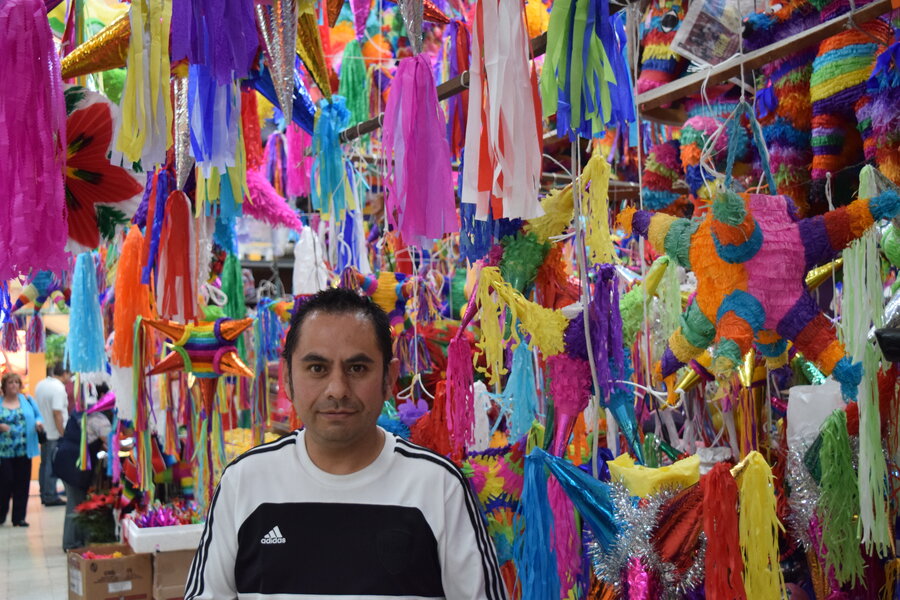Silver bells? In Mexico, breaking pinatas herald the Christmas season
Loading...
| Mexico City
It’s beginning to look a lot like Christmas in Mexico, but for Joshua Cruz, it’s not the parking lots full of pine trees or carols blasting from cafe speakers that put him in the holiday spirit.
“It’s not really Christmas time until I’m surrounded by hundreds of [star] piñatas,” says the third-generation piñata-maker, who is training his 17-year-old son to one day take the helm of the family business.
Mr. Cruz's stall, at an expansive market in central Mexico City, is enveloped by crepe-paper and hand-painted creations that he and his son construct. Passersby can’t avoid being tickled by streamers hanging from the tips of iconic seven-pointed star piñatas – some smaller than a shoebox, others bigger than a car.
The piñata may have originated in China, traveling to Italy, Spain, and eventually Mexico via conquistadors, but it’s an object deeply embedded in Mexican culture. The colorful party prop has transformed over the centuries from a Spanish tool for conversion to Christianity into a central part of birthday and other celebrations. But it still holds a special place in Christmas festivities.
Cruz says he sells about 300 piñatas in December alone, when "Posada" revelers traditionally mimic the journey of Mary and Joseph looking for a place to stay in Bethlehem. Typically, friends and family knock on one neighbor’s door after another in a processional that ends with food, drink, and piñatas – though sometimes they skip straight to the party.
Ancient tradition meets Christianity
One reason piñatas first resonated here, says Emilo Ortiz Marín at Mexico City’s Popular Art Museum, is that indigenous Maya populations had a similar tradition of breaking hanging clay pots before each harvest to guarantee a bountiful crop.
“It was an opportunity to mix indigenous and Western cultures and bring pagan beliefs closer to the church,” says Mr. Marín.
The Spanish used the seven-pointed piñata to teach about the seven mortal sins, and to illustrate how good can overcome evil in Christianity, Marín says. People are blindfolded to represent their innocence, then batter devilish temptation until it’s destroyed. They’re rewarded with the fruits of their faith.
Traditionally, that meant a wellspring of mandarins, sugarcane, peanuts, jicama, and Tejocotes, a tiny fruit similar to crabapples, spilling from a Christmas piñata.
Today, though, you’re more likely to find candy and plastic toys – or if you are the sons of piñata-makers, maybe baking flour, laughs Alfonso Lopez, Cruz’s older brother, remembering one particularly eventful Christmas Eve celebration. The boys liked to take full advantage of their positions as piñata-making assistants, filling the family’s piñatas with bizarre items to play practical jokes and add an extra element of surprise.
Despite their history, “piñatas are now more cultural than they are religious,” says Marín.
Drawing on pop culture
Craftsmen like Cruz and his family have made piñatas very much their own. Mr. Lopez recalls when his father first started to play around with piñatas in the shapes of people like television characters and other well-known figures in the 1950s. Lopez, who also makes piñatas and runs a nearby fruit stand, says proudly that the first thing he did after learning about the 9/11 terrorist attack in New York City was to create a piñata in the shape of Osama Bin Laden.
The process takes several days. First, they cover a mold – which to an untrained eye looks like bundles of plastic taped into the desired shape of the piñata – with paper maché. That takes a day or two to dry. Then the piñata form is split down the middle and pulled off the mold, leaving two hallow halves. The empty shells are taped together, and in the case of star piñatas, thin cardboard is rolled into pointed cones and attached to the main body of the piñata. It’s then decorated with tissue paper or paint, sparkly garlands, glitter, and other flare.
“It’s like therapy for me,” says Lopez. “I get lost in the process.”
Despite the threats to some traditions and crafts in Mexico, Marín believes piñatas are here to stay. “It’s a tradition that we break, but that will never disappear,” reads one explanation at the museum.
On this particular day, donkeys and Disney characters and even a handful of suit-clad US presidential hopeful Donald Trumps feature the market's stalls. But things have changed beyond just the shape and outward look of piñatas since Cruz’s grandparents first started selling them.
Cruz picks up a wooden pole and lightly taps two creations hanging from his stall. One makes a hollow thud, while the other has a louder, crisper ding to it.
“Ten percent of my customers still ask for piñatas with clay pots at the center, but most are looking for cardboard,” he says. That’s partly a question of safety: Shards of ceramic falling down on little kids could dampen a party. But it’s also representative of another trend he’s noticed in recent years.
“People complain to me about spending a lot on something they plan to break,” he says. His work ranges from 50 pesos ($3) for a palm-sized donkey piñata up to 1,000 pesos ($60) for a giant, 6-ft. star. He even ships to the United States.
“This is art,” Cruz says of the creations. “This is our tradition.”








